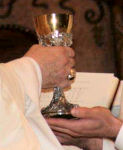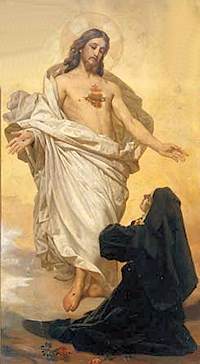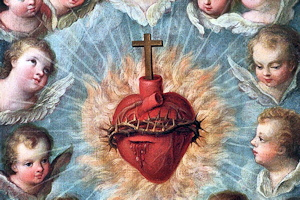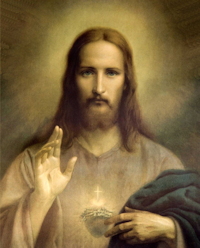» Enjoy our Liturgical Seasons series of e-books!
"I promise you in the excessive mercy of my Heart that my all-powerful love will grant to all those who receive Holy Communion on the First Fridays in nine consecutive months the grace of final perseverance; they shall not die in my disgrace, nor without receiving their sacraments. My divine Heart shall be their safe refuge in this last moment" (Jesus to St. Margaret Mary).
Sixteenth century Calvinism and seventeenth century Jansenism preached a distorted Christianity that substituted for God's love and sacrifice of His Son for all men the fearful idea that a whole section of humanity was inexorably damned.
The Church always countered this view with the infinite love of our Savior who died on the cross for all men. The institution of the feast of the Sacred Heart was soon to contribute to the creation among the faithful of a powerful current of devotion which since then has grown steadily stronger. The first Office and Mass of the Sacred Heart were composed by St. John Eudes, but the institution of the feast was a result of the appearances of our Lord to St. Margaret Mary Alacoque in 1675. The celebration of the feast was extended to the general calendar of the Church by Pius IX in 1856.
 The Congregation for the Clergy has today to be the World Day of Prayer for the Sanctification of Priests.
The Congregation for the Clergy has today to be the World Day of Prayer for the Sanctification of Priests.
Here is the message to all priests explaining this important day: It Is on Prayer That the Effectiveness of Action Depends and the Prayers for Priests, both for priests to say for themselves, and for lay people to say for priests.
The Most Sacred Heart of Jesus
 Today we celebrate The Solemnity of the Sacred Heart of Jesus. The Sacred Heart of Jesus is a devotional with long and historic provenance within Christianity, and in modern times has been established as a Solemnity for the universal Church.
Today we celebrate The Solemnity of the Sacred Heart of Jesus. The Sacred Heart of Jesus is a devotional with long and historic provenance within Christianity, and in modern times has been established as a Solemnity for the universal Church.
Catechism of the Catholic Church 478:
"Jesus knew and loved us each and all during his life, his agony and his Passion, and gave himself up for each one of us: "The Son of God. . . loved me and gave himself for me" (Gal 2:20). He has loved us all with a human heart. For this reason, the Sacred Heart of Jesus, pierced by our sins and for our salvation (Cf. Jn 19:34), "is quite rightly considered the chief sign and symbol of that. . . love with which the divine Redeemer continually loves the eternal Father and all human beings" without exception (Pius XII, Enc. Haurietis aquas (1956): DS 3924; cf. DS 3812).
Today is the Solemnity of the Most Sacred Heart of Jesus, designated the Friday after the Second Sunday after Pentecost (Corpus Christi Sunday). Sixteenth century Calvinism and seventeenth century Jansenism preached a distorted Christianity that substituted for God's love and sacrifice of His Son for all men the fearful idea that a whole section of humanity was inexorably damned.
The Church always countered this view with the infinite love of our Savior who died on the cross for all men. The institution of the feast of the Sacred Heart was soon to contribute to the creation among the faithful of a powerful current of devotion which since then has grown steadily stronger. The first Office and Mass of the Sacred Heart were composed by St. John Eudes, but the institution of the feast was a result of the appearances of our Lord to St. Margaret Mary Alacoque in 1675. The celebration of the feast was extended to the General Roman Calendar of the Church by Pius IX in 1856.
Today is the World Day of Prayer for the Sanctification of Priests. The World Day of Prayer for the Sanctification of Priests takes place every year on the Solemnity of the Most Sacred Heart of Jesus.
The Solemnity was first celebrated in France. The liturgy was approved by the local bishop at the behest of St. John Eudes, who celebrated the Mass on August 31, 1670. The celebration was quickly adopted in other places in France. In 1856, Pope Pius IX established the Feast of the Sacred Heart as obligatory for the whole Church.
But the devotion to the Sacred Heart of Jesus is much older. The beginnings of a devotion of the love of God symbolized by the heart of Jesus are found in the fathers of the Church, including Origen, St. Ambrose, St. Jerome, St. Augustine of Hippo, St. Hippolytus of Rome, St. Irenaeus, St. Justin Martyr, and St. Cyprian. In the 11th century this devotion found a renewal in the writings of Benedictine and Cistercian monasteries. In the 13th century, the Franciscan St. Bonaventure’s work “With You is the Source of Life” (which is the reading for the Divine Office on the Solemnity of the Sacred Heart) began to point to the heart as the fountain from which God’s love poured into our lives. Also in the 13th century, there was the “Vitis Mystica” (the mystical vine) a lengthy devotional to Jesus, which vividly describes the “Sacred Heart” of Jesus as the font and fullness of love poured into the world. This work is anonymous, but most often attributed to St. Bonaventure.
At the end of the 13th century, St. Gertrude, on the feast of St. John the Evangelist, had a vision in which she was allowed to rest her head near the wound in the Savior’s side. She heard the beating of the Divine Heart and asked John if, on the night of the Last Supper, he too had felt this beating heart, why then had he never spoken of the fact. John replied that this revelation had been reserved for subsequent ages when the world, having grown cold, would have need to rekindle its love.
In the late 17th century the devotion was renewed and adopted elsewhere, especially following the revelations to St. Marguerite Marie Alacoque. The saint, a cloistered nun of the Visitation Order, received several private revelations of the Sacred Heart, the first on December 27, 1673, and the final one 18 months later. The stained glass window centered in the sanctuary dome recalls the Saint and her vision.
Initially discouraged in her efforts to follow the instruction she had received in her visions, Alacoque was eventually able to convince her superior of the authenticity of her visions. She was unable, however, to convince a group of theologians of the validity of her apparitions, nor was she any more successful with many of the members of her own community. She eventually received the support of the community’s confessor who declared that the visions were genuine. Alacoque’s short devotional writing, “La Devotion au Sacré-Coeur de Jesus” (Devotion to the Sacred Heart of Jesus), was published posthumously in 1698. The devotion was fostered by the Jesuits and Franciscans, but it was not until the 1928 encyclical “Miserentissimus Redemptor” by Pope Pius XI that the Church validated the credibility of Alacoque’s visions of Jesus Christ in having “promised her [Alacoque] that all those who rendered this honor to His Heart would be endowed with an abundance of heavenly graces.”

In the late 19th century, Sr. Mary of the Divine Heart received a message from Christ. This eventually led the 1899 encyclical letter Annum Sacrum in which Leo XIII decreed that the consecration of the entire human race to the Sacred Heart of Jesus should take place on June 11, 1899.
On the 100th anniversary of the Feast of the Sacred Heart in a landmark encyclical, Haurietis aquas (Latin: “You will draw waters”; written May 15, 1956), Pope Pius XII began his reflection by drawing from Isaiah 12:3, a verse which alludes to the abundance of the supernatural graces which flow from the heart of Christ. Haurietis aquas called the whole Church to recognize the Sacred Heart as an important dimension of Christian spirituality. Pius XII gave two reasons why the Church gives the highest form of worship to the Heart of Jesus. The first rests on the principle whereby the believers recognize that Jesus’ Heart is hypostatically united to the “Person of the Incarnate Son of God Himself.” The second reason is derived from the fact that the Heart is the natural sign and symbol of Jesus’ boundless love for humans. The encyclical recalls that for human souls the wound in Christ’s side and the marks left by the nails have been “the chief sign and symbol of that love” that ever more incisively shaped their life from within.
In a letter on May 15, 2006, Benedict XVI wrote: “By encouraging devotion to the Heart of Jesus, [we exhort] believers to open themselves to the mystery of God and of his love and to allow themselves to be transformed by it. After 50 years, it is still a fitting task for Christians to continue to deepen their relationship with the Heart of Jesus, in such a way as to revive their faith in the saving love of God and to welcome Him ever better into their lives.
As the encyclical states, from this source, the Heart of Jesus, originates the true knowledge of Jesus Christ and a deeper experience of His love. Thus, according to Benedict XVI, we will be able to understand better what it means to know God’s love in Jesus Christ, to experience Him, keeping our gaze fixed on Him to the point that we live entirely on the experience of His love, so that we can subsequently witness to it to others.
—Excerpted from Friar Musings
The Sacred Heart of Jesus
 "Beloved brethren, since it had been ordained by a merciful Providence that the Church should be formed from the side of the crucified Christ and that the words of the Scriptures be fulfilled: They shall look upon Him whom they have pierced — a soldier armed with a lance opened the sacred Breast. The Blood mingled with water, which was shed from that pierced side, was the price of our salvation. Flowing from the hidden fount of the Sacred Heart, it gave to the sacraments their power of conferring the life of grace, and to those already living in Christ a draught of the living fount, gushing forth unto life eternal.
"Beloved brethren, since it had been ordained by a merciful Providence that the Church should be formed from the side of the crucified Christ and that the words of the Scriptures be fulfilled: They shall look upon Him whom they have pierced — a soldier armed with a lance opened the sacred Breast. The Blood mingled with water, which was shed from that pierced side, was the price of our salvation. Flowing from the hidden fount of the Sacred Heart, it gave to the sacraments their power of conferring the life of grace, and to those already living in Christ a draught of the living fount, gushing forth unto life eternal.
"Arise, therefore, O soul friendly to Christ! Cease not your vigil; bring close your lips, that you may draw waters from out the Savior's fountain. Oh, how good and how pleasant it is to dwell in this most Sacred Heart. Your Heart, dearest Jesus, is the great treasure, the precious jewel which we will find in the dug field of Your sacred Body. Who is there who would throw away this jewel? Rather would I throw away all my own jewels, my thoughts and my affections, and cast my cares upon Your Sacred Heart, which will nourish me without fail. I beg of You, sweet Jesus my God, place my prayer among those that You will answer. Draw me wholly into Your Heart. For unto this end Your side was pierced, that an entrance would lie open to us. Unto this end Your Heart was wounded, that detached from worldly tumult, we would be able to dwell in it.
"But above all, Your Heart was wounded so that a visible scar would enable us to see the invisible wound of Your love. For how could the ardor of Your love be better shown than by this, that not only Your Body but even Your very Heart was pierced with a lance? Truly the wounds of the flesh showed forth the wounds of the spirit. Who is there who would not love One so loving? My dearly beloved, let us pray that the Sacred Heart may deign to wound our heart still so hard, still so impenitent, and bind it with the sweet bonds of His love."
—St. Bonaventure
Highlights and Things to Do:
- Read more about the Sacred Heart of Jesus:
- From the Catholic Culture Library read Enthronement of the Sacred Heart of Jesus: Sacred Scripture by Bishop Raymond Burke.
- Read the encyclicals on the Sacred Heart from over the centuries:
- May 25, 1899, Pope Leo XIII: Annum Sacrum (On Consecration To The Sacred Heart)
- May 8, 1928, Pope Pius XI: Miserentissimus Redemptor (On Reparation To The Sacred Heart)
- May 3, 1932, Pope Pius XI: Caritate Christi Compulsi (On The Sacred Heart)
- May 15, 1956, Pope Pius XII: Hauerietis Aquas (On the Sacred Heart)
- Bake a heart shaped cake or cookies in honor of the Sacred Heart of Jesus or a heart-Shaped Pizza and/or heart Mexican Tin Art, directions here. See more food ideas at Catholic Cuisine.
- Read The 12 Promises of the Sacred Heart of Jesus.
- Fr. Eugene Lobo, SJ explains the readings for the feast.






